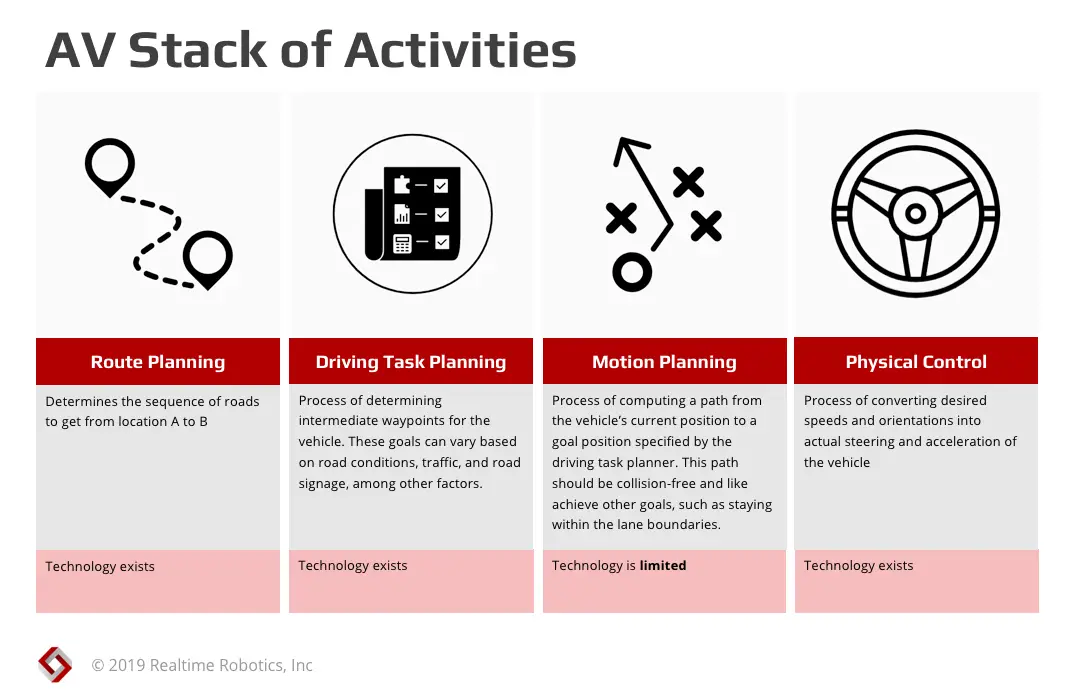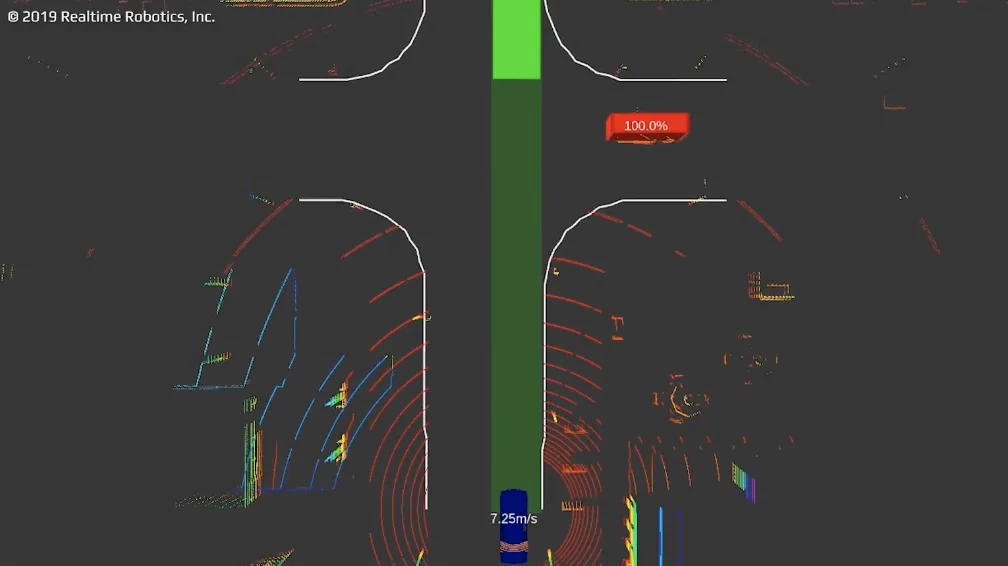Realtime announced its first commercial contract with an undisclosed multinational customer to apply its real-time motion planning processors in a high volume, unstructured pick and place work-cell. The contract is worth up to $15 million rolled out across a three-year horizon.
Blog
Realtime receives confirmation of DARPA SBIR selection
Realtime received notification today of DARPA’s selection of Realtime’s proposal titled:
‘Accelerated Low-power Motion Planning for Real-time Interactive Autonomy‘
Abstract:
The inability to plan in real-time is a major reason why robot manufacturing is restricted to high-value, high-volume products, in carefully engineered factories where robots blindly repeat pre-programmed trajectories. Today, robots simply cannot generate collision-free motion on the fly. We are solving this core problemreal-time motion planning in unstructured, fluid environments and on diverse Size, Weight, and Power (SWaP)-constrained robot platformsby co-designing custom motion planning hardware with novel planning algorithms. Just like the GPUs that revolutionized graphics, our motion planning processors will exploit the phenomenal speed and massive parallelism available to dedicated circuitry to make thousands of plans per second. Real-time motion planning is only possible with the combination of specialized hardware and novel algorithms, and we are the first to develop it. Our processors will generate thousands of plans per second, which is faster than perception and enables the robot to create multiple viable motion plans and choose the one that is most convenient (e.g., for grasping) or least likely to collide with dynamic obstacles with uncertain trajectories. Learn More.
Realtime Robotics, Inc Awarded Competitive Grant from the National Science Foundation
Small Business Innovation Research Program Provides Seed Funding for R&D
Boston, MA, July 3, 2018 – Realtime Robotics has been awarded a National Science Foundation (NSF) Small Business Innovation Research (SBIR) grant for$225,000 to conduct research and development (R&D) work on Risk-Aware Motion Planning for Autonomous Vehicles.
This R&D work will change the way that autonomous vehicles plan their motions, particularly in challenging urban driving scenarios. Realtime Robotics is working on a special-purpose computer processor that can plan thousands of times faster than existing solutions, and this speed will enable it to make many plans at a time, each of which considers a different possible set of behaviors from the other agents—cars, bicycles, pedestrians—in the environment. This technology will enable risk-aware, normal speed driving, which is critical for widespread adoption by the general public.
“The National Science Foundation supports small businesses with the most innovative, cutting-edge ideas that have the potential to become great commercial successes and make huge societal impacts… We hope that this seed funding will spark solutions to some of the most important challenges of our time across all areas of science and technology.”
— Barry Johnson, Director of the NSF’s Division of Industrial Innovation and Partnerships
As explained by Peter Howard, CEO of Boston-based Realtime Robotics, “The new technology is a game-changer for autonomous vehicles, which currently look impressive on the freeway, but drive slowly and haltingly in urban environments. Our technology will make autonomous cars drive like humans—in that they drive at normal speeds and plan for unpredictable behaviors—just much better. Computer processors don’t get distracted by their phones or drowsy after long hours of driving.”
Once a small business is awarded a Phase I SBIR/STTR grant (up to $225,000), it becomes eligible to apply for a Phase II grant (up to $750,000). Small businesses with Phase II grants are eligible to receive up to $500,000 in additional matching funds with qualifying third-party investment or sales.
NSF accepts Phase I proposals from small businesses twice annually in June and December. Small businesses with innovative science and technology solutions, and commercial potential are encouraged to apply. All proposals submitted to the NSF SBIR/STTR program undergo a rigorous merit-based review process.
To learn more about America’s Seed Fund powered by NSF, visit: https://seedfund.nsf.gov/
About the National Science Foundation’s Small Business Programs
America’s Seed Fund powered by NSF awards $200 million annually to startups and small businesses, transforming scientific discovery into products and services with commercial and societal impact. Startups working across almost all areas of science and technology can receive up to $1.5 million in non-dilutive funds to support research and development (R&D), helping de-risk technology for commercial success. America’s Seed Fund is congressionally mandated through the Small Business Innovation Research (SBIR) program. The NSF is an independent federal agency with a budget of about $7.8 billion that supports fundamental research and education across all fields of science and engineering.
Realtime Robotics closes $2 million seed round
Investors include SPARX Group Ltd., Scrum Ventures, and Toyota AI Ventures
BOSTON, MA – October 30, 2017— Realtime Robotics, which develops breakthrough technology that unleashes robots and autonomous vehicles from their current limitations, announced today that it has secured $2 million in seed funding to further its growth. Key investors in the seed round include SPARX Group Ltd., Scrum Ventures, and Toyota AI Ventures, a venture capital subsidiary of Toyota Research Institute (TRI).
Founded in March 2016 by Duke University professors Dan Sorin and George Konidaris, Realtime Robotics enables complex robotic motion planning tasks to be accomplished up to 10,000 times faster than previously possible using a proprietary special-purpose processor – allowing robotic systems to instantly react to their environments, and compute how and where to move as their situation is changing. This groundbreaking ability to instantly plan motion in response to rapidly changing conditions overcomes one of the primary challenges preventing robots and autonomous vehicles from achieving their enormous potential.
“We’re currently working with major multinational customers to create highly adaptable robotic systems for application to new classes of industrial tasks, many times larger than the existing robotics market,” said Realtime Robotics CEO Peter Howard. “In addition, we’re excited about the role that Realtime’s technology can play in improving the safety of emerging autonomous driving platforms, even in complex urban driving environments.”
Realtime’s lightning-fast processor enables robots with sophisticated arms to be utilized in dynamic environments, dramatically increasing the types of industrial tasks they can perform. Realtime’s processor can also be used by autonomous vehicles to help them operate at normal speeds—like humans, but safer—instead of slowing to a crawl when there is uncertainty regarding other cars, bikes, or pedestrians.
“The technology being developed by Realtime Robotics is game-changing, and we’re proud to be part of this investment through Toyota AI Ventures,” said James Kuffner, TRI’s Chief Technology Officer. “We share Realtime’s commitment to enabling robotic systems to perform complex tasks quicker, safer and more efficiently.”
Realtime Robotics is hiring talented roboticists and software engineers to join its founding team in realizing the broad market applications for this breakthrough technology. The company has a growing list of clients, ample funding, exciting technology, and broad application areas under development. Get in touch for more information or explore career opportunities.
Media Contact
Maggie Weeks
marketing@rtr.ai
James Kuffner, CTO at Toyota Research Institute, blogs about Realtime Robotics
Welcoming Realtime Robotics to the Toyota AI Ventures portfolio
By James Kuffner, Chief Technology Officer, Toyota Research Institute
Excerpt:
Visions of the future often feature robots. Whether working in factories, attending to humans, or piloting our cars, they compose a large part of our futurescape. While we imagine how robots could vastly improve our lives, a challenge roboticists inevitably come up against is: how do we build robots that can safely move in our complex world? The field of robot motion planning has emerged with the goal of addressing this challenge.
We welcome Jason Barton to our team!
Realtime Robotics on-boards Jason Barton as Chief Commercial Officer
Bringing robotics industry and global go-to-market expertise to robotics start-up
Boston, MA – Nov 26th, 2018 –Realtime Robotics, Inc. today announced it has hired Jason Barton to serve as the Company’s Chief Commercial Officer, effective October 30th, 2018. Founded by Prof. George Konidaris and Prof. Daniel Sorin, Realtime Robotics has invented a specialized processor for generating safe robotic motion plans in microseconds, enabling robots to function in unstructured, collaborative works-spaces, reacting to a dynamic world in the instant changes are perceived. The Company is heading toward production and sales of its products, and has brought Mr. Barton in to guide the global commercial strategy and lead revenue growth.
Mr. Barton has 20+ years of sales and marketing leadership experience selling high-tech disruptive products and solutions into global markets. At Rethink Robotics, he helped create the collaborative robot category building a sales and support network that served manufacturing plants across the globe. Prior to this he has served as COO of EnergyHub, a leader in connected home energy management solutions. He also ran sales and marketing at Segway, and for Palm’s US Enterprise business. Jason earned a BA Honors Degree from the University of Wales in the UK.
I’m delighted to be joining such a talented and innovative team” said Barton. “Realtime’s technology is a game changer for robot applications and autonomous vehicles. Safe, quick, collision-free motion planning is instrumental in enabling the adoption of robotic solutions in the unstructured and dynamic environments that make up the bulk of human activity.”
“We are all thrilled to have Jason join us at this key juncture, as we finish out our successful Beta phase and move toward a series of progressive commercial releases over the next 18 months. Jason’s depth of experience both in industrial robotics and in early stage transitions to commercialization is a perfect fit, and already generating enormous value”, said Peter Howard, Realtime Robotics’ CEO.
About Realtime Robotics
Realtime Robotics was founded in March 2016 by Duke University professors Dan Sorin (Computer Architecture), George Konidaris (Robotics and Motion Planning), and a few of their top researchers, based on their groundbreaking DARPA-funded research. The Company is currently working with major multinational customers to create highly adaptable robotic systems for application to the vast majority of industrial tasks which are in dynamic environments, as well as to enable autonomous driving platforms to achieve superior safety at normal driving speeds, even in the complex urban driving environments that are the key challenge to the technology’s widespread adoption.
Realtime Robotics in the news: Medium
Self-driving Cars vs Humans — 100x Power Efficiency Gap
By Nitin Vaish
Excerpt:
The development of self-driving cars is moving rapidly, with Waymo launching the self-driving car service on the road without front safety driver earlier this month. Kudos to the team! It’s an awesome outcome of the research that was spurred by Darpa urban challenge almost a decade ago.
Realtime Robotics Named Finalist in Automate Launch Pad Startup Competition
Enables Robots to Operate Collision-Free in Dynamic, Unstructured Environments
BOSTON (Mar. 26, 2019) – Realtime Robotics, an innovative automation startup incubated at MassRobotics, has been selected from a highly competitive field as a finalist in the Launch Pad Startup Competition to be held at Automate in Chicago. The company, along with six others, will pitch its technology solution to a panel of judges and vie for a $10,000 prize on Wed., Apr. 10 at 3 pm CT at McCormick Place’s “Win the Future” theater.
Realtime Robotics is changing the way robots interact with the real world of factory and warehouse operations. While demand for increased automation among manufacturers and distributors of all sizes is on the rise, there are significant obstacles to the widespread adoption of both industrial and collaborative robots:
- the costs associated with ensuring the safety of people in and around the work-cell
- the inability to navigate seamlessly in dynamic environments
- the need to slow down performance in order for robots to be safe and accurate
Realtime Robotics’ solution for collision-free motion planning eliminates these challenges. Built on next-generation computer processing and innovative software, its products make it possible for robots to navigate dynamic environments smoothly, quickly and intuitively.
“We’re excited to be a part of this showcase of companies that are driving automation forward,” said Jason Barton, Chief Commercial Officer of Realtime Robotics. “We believe that when robots break free from the constraints which limit their ability to work with people, the real benefits of automation will finally become a reality.”
To learn more about Realtime Robotics, its technology and the business benefits it offers, please visit booth #9649 at the Automate show, and the company’s website.
About Realtime Robotics
Boston-based Realtime Robotics was founded in 2016 by Duke University professors Dan Sorin, George Konidaris and top researchers Sean Murray and Will Floyd-Jones, based on groundbreaking DARPA-funded research in motion planning. The company is working with global customers and partners to transform industrial automation by enabling robots to recognize, respond and decide how and where to move in milliseconds, even in variable environments.
Company contact:
Maggie Weeks
marketing@rtr.ai
Solving the Autonomous Vehicle Safety Challenges
The future of driving is automated. The certainty of this future—despite well-publicized delays and technical challenges—derives from the numerous and substantial benefits of autonomous vehicles (AVs). The potential safety benefits are extraordinary. At least 31% of road deaths happen in DUI crashes, and an additional 10% occur when the driver is either distracted or drowsy; up to 90% of all accidents are caused by driver error. An NHTSA report estimated the total societal harm from vehicle crashes at $836 billion, a number that could be significantly mitigated with autonomous vehicles. In addition to safety, AVs would provide mobility for the disabled, elderly, and children who cannot drive themselves. And, perhaps most practically, AVs would free most of us up from having to drive ourselves when commuting to and from work.
Given all of the benefits of AVs and the hype about them, why are they not here already? Yes, there are promotional videos in which AVs glide down the freeway. Yes, pilot programs exist in which a small number of AVs operate in a constrained area and only under optimal conditions (e.g., good lighting, good road conditions). Yes, many new vehicles come equipped with more autonomy than the simple cruise control of previous decades. And yes, many of us have seen videos of AVs poking along hesitantly in urban environments. Nevertheless, none of us are routinely lounging in an AV that is driving naturally—at normal speeds and without being confounded by four-way stops and pedestrians—through a city.
The potential market is enormous with the latest data predicting that AVs will be the fastest-growing automotive sector with sales crossing more than 11 million units by 2033 with a compound annual growth rate of 76.09 percent to 2033. Allied Market Research estimates that the AV market will reach $54 billion by the end of 2019 and then will explode to $556 billion by 2026. The anticipated growth is reflected in the flurry of M&A activity in the sector as automakers, suppliers and technology players in the space to continue vertical integration and consolidation.
However, before fully autonomous vehicles can become commonplace in urban environments, there are still safety challenges that need to be overcome. Solving this issue is the key to making autonomous driving and vehicles a reality. In our next blog, we will dive into autonomous driving and how we’re overcoming the critical technical challenge.
You can also read more about our philosophy in this recent IEEE article.
Autonomous Driving and the Need For Motion Planning
Our last blog outlined why autonomous vehicles are not a passing fad and are the future of transportation. However to realize their full potential motion planning is an essential component that will address a myriad of safety challenges. Before we dive into motion planning let’s look at autonomous driving in more detail.
There are many aspects to autonomous driving, all of which need to perform well. You can think of autonomous driving as a four-level stack of activities, in the following top-down order: route planning, behavior planning, motion planning, and physical control.
- Route Planning determines the sequence of roads to get from location A to B.
- Behavior Planning is the process of determining specific, concrete waypoints along the planned route. These goals can vary based on road conditions, traffic, and road signage, among other factors.
- Motion Planning computes a path from the vehicle’s current position to a waypoint specified by the driving task planner. This path should be collision-free and likely achieve other goals, such as staying within the lane boundaries.
- Physical Control is the process of converting desired speeds and orientations into actual steering and acceleration of the vehicle.
All four levels rely on accurate perception and this is where the majority of solutions continue to emerge. However, control of the car ultimately boils down to these four control levels, and of these, motion planning is the current technical bottleneck and is the primary obstacle to the adoption of AVs.
The current state-of-the-art for motion planning leverages high-performance commodity GPUs. Yet even with a “500-watt supercomputer in the trunk,” as one of our customers recently described it to us, they could compute only three plans per second. Even given high-performance GPUs, motion planning is too computationally difficult for commodity processors to achieve the required performance.

What is the required motion planning performance? At an absolute minimum, the motion planner must be able to react—that is, create a new motion plan—as fast as an alert human driver. That reaction time is on the order of 250msec, and one can imagine current technology evolving to reach that planning speed, albeit at an exorbitant power budget. But we would like to achieve far more than this bare minimum; one of the attractive features of autonomous vehicles is the potential to achieve far greater safety than that achievable by a human driver. Significantly faster motion planning would translate to much faster reaction times. The difference between reaction times of 250msec1 and 5msec2, for a vehicle traveling at 40mph, is the difference between 15 feet and 0.3 feet traveled before reacting.
Motion planning speed is clearly beneficial for safety, but it offers other important benefits. When motion planning is slow, an AV cannot react quickly to dynamic, non-deterministic agents in its environment, including pedestrians, bicyclists, and other vehicles. When you can’t react quickly, you must move more slowly and more cautiously. Videos of AVs driving in urban environments reveal that they drive slowly and haltingly, having to compensate for their inability to rapidly re-plan. While such hesitant driving is frustrating to the passenger, it is also likely to aggravate other drivers who are stuck behind the autonomous vehicle or waiting for it to navigate a four-way stop. Aggravating the driving public is dangerous for business, particularly if the driving public clamors for legislation to restrict current hesitant-based driving AVs.
The need for motion planning is clear and our final blog in this series explains how we are making this possible.

¹250ms is the average human reaction time to the visual stimulus, https://www.ncbi.nlm.nih.gov/pmc/articles/PMC4456887/
²Realtime Robotic’s AV motion planner can plan in 1ms, an additional 4 ms is taken to receive and process sensor data.









